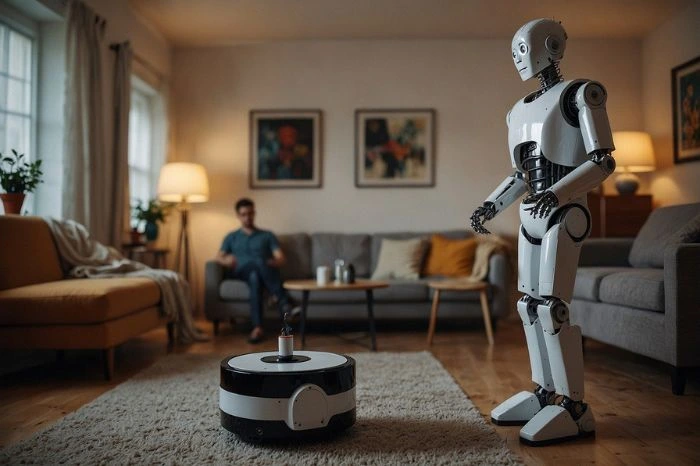Wear OS 5 is here, and it’s powering the latest Android smartwatches. It brings faster speeds, better battery life, and smarter fitness tracking. Created by Google and built on Android, it stands tall against Apple’s WatchOS and Samsung’s older Tizen system. Samsung even made their own special version called One UI 6 Watch that runs on Wear OS 5. Then, in March 2025, Google dropped Wear OS 5.1 with even more improvements. In this article, we’ll take a look at everything new, the watches that can get it, and where Wear OS is heading next.
What’s Wear OS 5 All About? Top Features
First off, Wear OS 5 makes everything smoother. Getting around the system is way easier now. Apps load faster, and everything feels more connected to your Android phone.
They even made the app launcher better—now it’s grid-based, so finding apps is quicker.
Some major highlights include:
1. Super Speedy Performance
Apps open 25% faster, and animations glide like butter. Recent tech and Google’s Hybrid Wear OS setup push tasks to a low-power chip, keeping things zippy.
2. Battery That Lasts
Your watch can go two days without charging. Running a marathon? It uses 20% less juice, thanks to smarter GPS and heart rate tricks.
3. Fitness and Health Tracking
Google Fit now tracks heart rate, sleep, oxygen levels, and even ECG. Runners get new stats like Ground Contact Time, Stride Length, Vertical Oscillation, and Vertical Ratio, shareable through Health Connect. Set “debounced goals,” like keeping your heart rate in a zone, and get alerts if you slip.
Pixel Watches bring Fitbit goodies: Cardio Load, Training Load, Daily Readiness, running form tips, and interval workouts.
4. Android Connection Magic
Reply to texts, check alerts, or control smart home gear without your phone. New apps include Recorder for saving audio (syncs with Pixel phones), better Pixel Camera controls to peek through the viewfinder or switch modes, and picking where media plays.
5. Watch Face Format (WFF)
The XML-based WFF saves battery and offers cool “Flavors” for customization, plus fitness progress bars, pie-chart stats, and weather updates. But it blocks apps like Facer, leaving 500,000+ watch faces unusable.
Wear OS 5 vs The Competition
In its most delinquent update, Google’s alternate has set Wear OS five in a remarkably competitive position analogized to Tizen, Samsung, and the Watch OS, Apple. This study presents challenges to other platforms that predict by 2026 Wear OS could capture as much as 20% of the Wear OS Five continues to develop, Google will most likely have even more new features, particularly regarding AI-based health management and voice control of the interface.
Wear OS watches have already expanded their functionality to integrate with Google Assistant and guide third-party apps global market for Smart Watches done by IDC. As macroeconomic recovery continues, The High-end US market Smart Watches hub is expected to grow moderately in 2024 compared to 2023. This way Wear OS may find itself in tough competition with other systems because the wearable industry is predicted to be worth $54 billion in revenue globally.
Facer Users Await The Full Adaptation of All The Watches to Wear Os 5
Some of the Facer users are waiting for full Wear OS five support which is currently being developed. These more pristine watches like the Pixel Watch 3, Samsung Galaxy Watch 7, and Galaxy Watch Ultra are encountering hindrances of the new Watch Face Format released by Google, which unfortunately restricts Facer’s 500000+ face watch and 10 million downloads.
Future Prospects of Wear OS Five
As Wear OS Five continues to develop, Google will most likely have even more new features, particularly regarding AI-based health management and voice control of the interface. Wear OS alerts have already developed their functionality to combine with Google Assistant and guide third-party apps.
| Feature | Wear OS 5 | Wear OS 4 | Wear OS 3 | Wear OS 2 |
|---|---|---|---|---|
| Performance | 25% faster app loading and smoother animations | Prominent performance gains, but slower than Wear OS 5 | Decent performance but more lag during multitasking | Slower performance, especially on older devices |
| Battery Life | More than 2 days | Typically up to 1.5 days | Around 1 to 1.5 days | Often less than a day, depending on usage |
| Health & Fitness Tracking | Refined metrics like ECG, SpO2, sleep stalking, heart pace monitoring | Google Fit integration with primary metrics like heart rate and movement | Basic heart rate monitoring and fitness tracking | Limited tracking features, mostly step coun |
| Google Assistant Integration | Seamless voice control with enhanced capabilities | Strong Google Assistant integration but less refined than Wear OS 5 | Basic voice commands supported | Minimal support for voice commands |
| Device Compatibility | Backwards compatible with most Wear OS 3/4 devices, better optimized for new hardware. | Compatible with most Wear OS 3 devices | Some Wear OS 2 devices are supported, but limited |
Conclusion
Wear OS 5 takes the title of the revolution hostage about the technology of wearables, offering unparalleled interfacing performance, high-quality health sensors and perfect connection. The future can only get better as more devices are being developed to support Wear OS 5. The competition might be fierce. But there’s no doubt that Google’s wearable ecosystem gaining traction and growing continuously.
Find more details:
How to Free Up Storage on Your Watch
How to Add Apps on Your Apple Watch
Best Free Apple Watch Apps
How to Remove Them Easily



